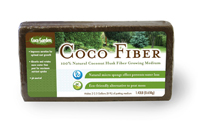
|
|
|
|

|

|

|
Coco Fiber for Composters, Compost Pails and Crocks
100% natural coconut husk fiber growing medium. Available in a range of sizes, see pack size drop down opposite for details. Go green. Go coco.
|
|
| Coco Fiber for Composters | |
|
|
Coco Fiber
From the ManufacturerCoco fiber is a must for composting because it greatly improves decomposition and prevents the leaching of valuable compost nutrients. Add coco fiber every time you add green matter to your compost pile or bin. Coco fiber is perfect for use in kitchen compost pails to eliminate odor at the source by absorbing excess liquid. Add a layer of coco fiber every time you add food scraps to your kitchen compost pail. Coco fiber will continue to work in the compost bin after being transferred from the kitchen compost pail and also in the finished compost. Coco fiber's ability to maintain a balanced micro-climate makes it the perfect choice for bedding in worm composting. Coco Garden compresses its coco fiber into a convenient light weight package that expands several times its size when placed in water. Coco Garden coco fiber is a 100% natural eco-friendly alternative to peat based potting mixes. Peat moss is extracted from peat bogs that take thousands of years to form and years to recover and therefore is not a renewable resource. Coco Garden coco fiber is a completely renewable resource made from 100% natural recycled fibers of the coconut husk. Coco fiber's micro sponge effect dramatically increases the water retention of soil and improves aeration, ensuring optimal root growth and maximum water and nutrient uptake for lawn grasses and container and garden plants. Use anytime you have a need for a potting medium. Coco fiber is excellent for use as a seed starter, planting seedlings and transferring plants. Can be added to dry soil conditions to improve water retention and also for soils high in clay to improve aeration and root growth. When compared to conventional potting mixes compressed coco fiber lasts longer, requires significantly less packaging material and has a lower shipping weight and volume which greatly reduces its impact on the planet. Coco Fiber in Collection Pails/Compost Crock: Generally one must take the disc or brick of Coco Fiber and rehydrate and decompress it by placing in a container of water.
Once the fiber has expanded its best to dry it out by leaving the fiber
out on your porch or deck or at the very least in an open bucket in your
kitchen. Coco fiber works best for collection pails when its its
completely dried out. The reason for drying is that the coco fiber can
then be added each time you add green matter to your composter and it
will immediately absorb excess moisture to prevent odor and improper
breakdown. If you store coco fiber in expanded dry form you will have
the best results. Each time you add green matter to your collection pail
or compost crock add a layer of coco fiber to completely cover the
newly added green matter. You will notice less odor and pests in the
collection pail. When you are ready to transfer your collection pail to a
larger composter the material will already be premixed with green and
brown matter.
Go green. Go coco. One 1.43-Pound (650-Gram) brick makes 2-2.5-Gallon (8-9l) of potting medium. |